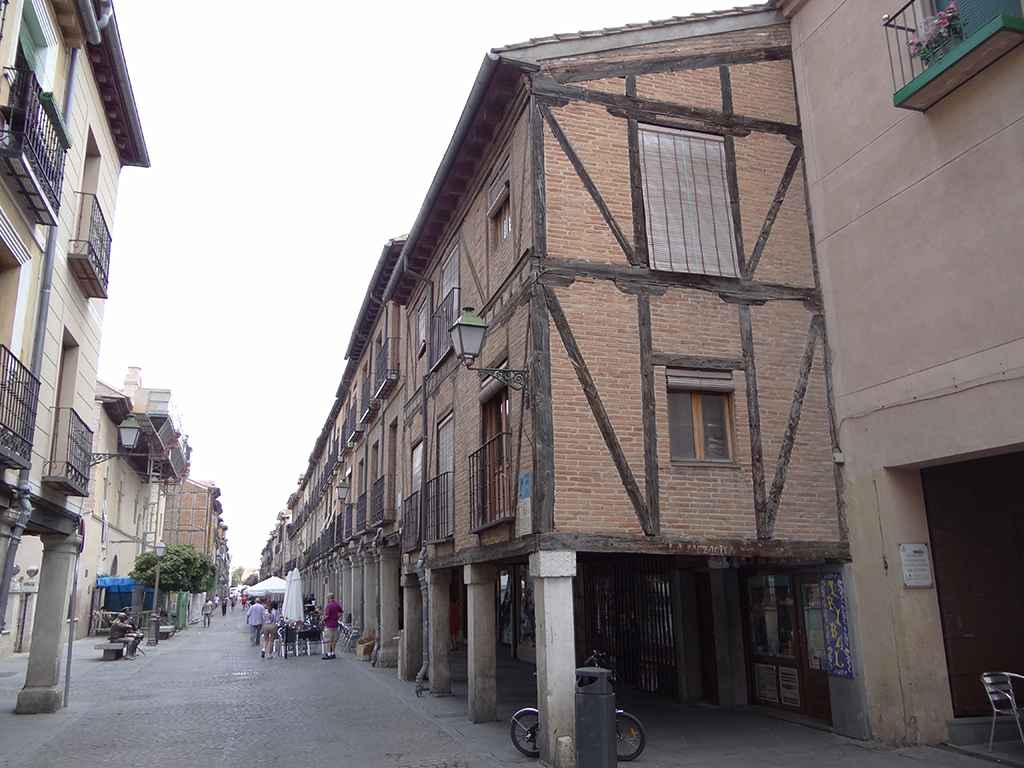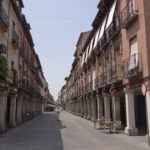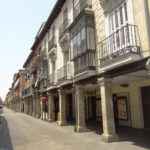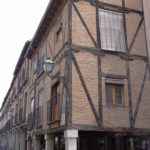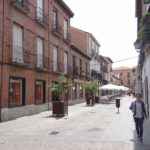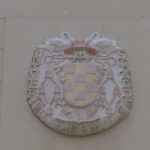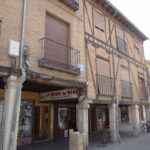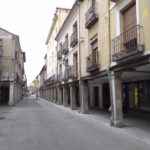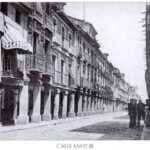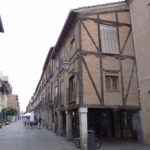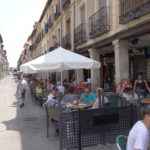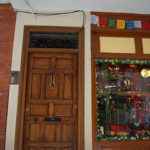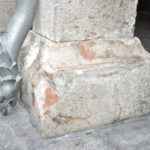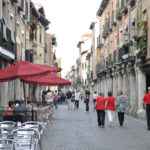Este texto también está disponible en español
Alcala’s calle Mayor is considered the main artery of the city’s centre and holds, along with its age —it dates back to the eighteenth century—, the value of being the longest street with arcades in its whole length in Spain, and the second in Europe, after Saint Luca portico in Bolonia.
Calle Mayor constitutes the perfect example of the fundamental role played by main streets in Spanish towns and cities, the epicenter of city daily live: work, arrangements, shopping, greetings and farewells… Whether working days or not, you will see people wondering around, and the families’ babble while going back and forth the street, sitting in bar terraces, or chatting on Sunday or Holy Days of Obligation.
The arcades
The calle Mayor has 390 meters long and 8 meters wide. It is situated in such a way that links two of the most emblematic squares of the Alcalá’s historical city center: Cervantes and Santos Niños —the latter placed right at the end of calle Mayor where the properly named Casa Tapón (Spanish pun, meaning Cap House) is located.
The street was constructed upon the Caesar Augusta’s Roman road route, which, in the old days, led to the Roman city of Complutum. The feature whereby every visitor remembers this place is its arcades, made up of columns, which support the weight of the 2 or 3 story houses above.
At first, in the Middle Ages, columns were merely lumbers, afterwards substituted, in the fourteenth century, by rounded stone columns and, in the nineteenth century, by square lumbers. Nowadays, it is still possible to observe several of the original rounded columns, for instance, at number 32. As a curiosity, some rest of the painting’s colors −blue, red and yellow− that used to cover these columns during Spanish Golden Age’s celebrations can easily be noticed.
An additional singularity of the longest arcade of Spain and almost Europe is, ironically, the lack of the typical arcades themselves: the stretch is now at the façade of the Antezana’s Hospital, also known as the Hospitalillo and located next to the Cervantes Birthplace Museum, which houses a small front garden.
Antezana’s Hospital has always been distinguished from any other locations along the street — in which lower stories had been occupied by shops and workshops, whereas in the upper levels there were only houses —, due to its remarkable architecture and the singularity of its healthcare facilities. There are supplementary stretches with no arcades because of accidents, fires or building works in which some columns were withdrawn and never replaced.
The Jewish Quarter
In 1492, the Jews were officially expelled from Spain, but in that and in previous centuries, they inhabited, in Alcalá, in their Jew Quarters or Aljamas. Such quarters were precisely placed surrounding the calle Mayor, commercial center of the city at the time. That extent of time is known as the period of “the three cultures”, as Jews, Muslims and Christians lived together in the city with, indeed, clearly defined boundaries.
If you walk from Plaza de Cervantes down calle Mayor on the left sidewalk, you will see that, at number 37, a passageway leads to a paved square known as the Corral de la Sinagoga.
A bit further ahead on the same street, on the left, there is another passageway, and both the Corral de la Sinagoga and the second entrance will take you to what is currently known as the Plaza de los Irlandeses. You will find that second corridor right opposite to calle Imagen —another street full of history, as it was the place where Manuel Azaña, President of the Second Spanish Republic, and son of the city’s Major at the time, Esteban Azaña, was born.
Those are the two passageways leading from calle Mayor to the Synagogue built in that site. The Synagogue, long ago destroyed by a fire, also leads to the current number 10 of Carmen Calzado Street. This was the Great Synagogue, one of the two that originally laid in the Jewish Quarter of Alcalá. The other —the Minor Synagogue, next to the convent-school of Santa María Egipcíaca—, was in calle Santiago, parallel to calle Mayor, and accessible by calle de Cervantes, Imagen and Nueva .
Peepholes
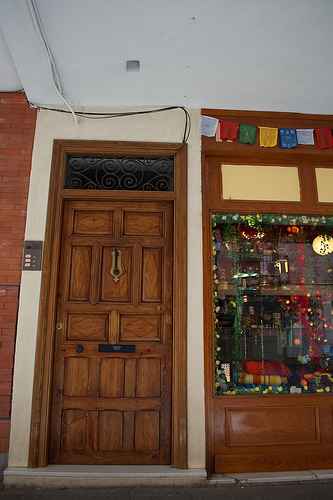 Visitors of the calle Mayor should not forget to focus their attention, while walking along the always-full-of-charming street, to the peepholes. In order to found them, you should explore the arcades’ roof, for instance, at numbers 13 and 32. Peepholes are an added historical curiosity, Jews merchants used them with the same intention as nowadays, that is, to know who is knocking at the door.
Visitors of the calle Mayor should not forget to focus their attention, while walking along the always-full-of-charming street, to the peepholes. In order to found them, you should explore the arcades’ roof, for instance, at numbers 13 and 32. Peepholes are an added historical curiosity, Jews merchants used them with the same intention as nowadays, that is, to know who is knocking at the door.
There are yet further curiosities about those peepholes. The square holes −of about 10 centimeters− were not built into the doors, but into the arcade’s roof, to wit, through the floor of the upper house. Thus, peepholes proved being useful for the inhabitants of the houses not only to confirm whether visitors were welcomed or not; but because they could also drop the keys through that hole, so as to allow guests to open the door and comfortably come upstairs.
Since 1986, the calle Mayor is a paved pedestrian zone intended for the transit of passers-by from one side of the city to the other, to any of the countless stores, bars and restaurants, terraces, bookshops or courtyards; or even to see some performance or play at the Salón Cervantes Theatre, in Cervantes Street.
Image gallery:
On video:
English:
Spanish:
Additional information:
- Rutas del patrimonio
- Rincón del Vago
- Club Tarbut Sefarad de Alcalá
- Concejalía de Turismo del Ayuntamiento de Alcalá de Henares
- enciclopedia.us.es
Where is it
Sigue disfrutando de Dream Alcalá:
- Telegram: Recibe nuestras noticias y contenido exclusivo (clic aquí).
- Newsletter: Recibe cada tarde un correo con nuestras últimas noticias (clic aquí).
- YouTube: Suscríbete para ver nuestros mejores vídeos (clic aquí).
 Sé tú el periodista: envíanos tus fotos o noticias a través de Telegram.
Sé tú el periodista: envíanos tus fotos o noticias a través de Telegram.

